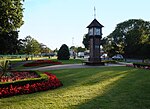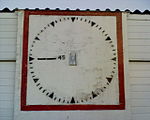Northolt Manor

Northolt Manor is a 1.8 hectare scheduled monument, local nature reserve and Site of Borough Importance for Nature Conservation, Grade II, in Northolt in the London Borough of Ealing. It is owned and managed by Ealing Council.Archaeological excavations from 1950 show that the site has been occupied since at least the 7th to early 8th centuries. Around 1300 a moat was dug, and later in the century the first stone buildings were erected to make a moated manor house. It was demolished in the eighteenth century. In 1935 the land was purchased by the local authority for public open space.The site has meadows, scrub, woodlands, wetlands and ponds. There is access from Court Farm Road.
Excerpt from the Wikipedia article Northolt Manor (License: CC BY-SA 3.0, Authors, Images).Northolt Manor
Ealing Road, London
Geographical coordinates (GPS) Address Nearby Places Show on map
Geographical coordinates (GPS)
| Latitude | Longitude |
|---|---|
| N 51.5444 ° | E -0.369 ° |
Address
St Mary's
Ealing Road
UB5 6AA London (London Borough of Ealing)
England, United Kingdom
Open on Google Maps




